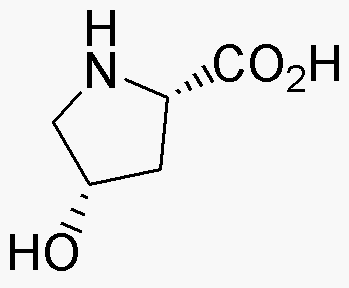cis-L-4-Hydroxyproline is widely utilized in research focused on:
- Pharmaceutical Development: This compound serves as a building block in the synthesis of various pharmaceuticals, particularly in the development of drugs targeting collagen-related diseases.
- Biotechnology: It plays a crucial role in the production of collagen and gelatin, which are essential for tissue engineering and regenerative medicine applications.
- Cosmetic Formulations: Due to its moisturizing properties, it is commonly used in skincare products to improve skin hydration and elasticity.
- Food Industry: As a food additive, it enhances the nutritional profile of products by contributing to amino acid balance, particularly in protein supplements.
- Research in Structural Biology: It is utilized in peptide synthesis for studying protein structures, aiding researchers in understanding protein folding and stability.
General Information
Properties
Safety and Regulations
Applications
cis-L-4-Hydroxyproline is widely utilized in research focused on:
- Pharmaceutical Development: This compound serves as a building block in the synthesis of various pharmaceuticals, particularly in the development of drugs targeting collagen-related diseases.
- Biotechnology: It plays a crucial role in the production of collagen and gelatin, which are essential for tissue engineering and regenerative medicine applications.
- Cosmetic Formulations: Due to its moisturizing properties, it is commonly used in skincare products to improve skin hydration and elasticity.
- Food Industry: As a food additive, it enhances the nutritional profile of products by contributing to amino acid balance, particularly in protein supplements.
- Research in Structural Biology: It is utilized in peptide synthesis for studying protein structures, aiding researchers in understanding protein folding and stability.
Documents
Safety Data Sheets (SDS)
The SDS provides comprehensive safety information on handling, storage, and disposal of the product.
Product Specification (PS)
The PS provides a comprehensive breakdown of the product’s properties, including chemical composition, physical state, purity, and storage requirements. It also details acceptable quality ranges and the product's intended applications.
Certificates of Analysis (COA)
Search for Certificates of Analysis (COA) by entering the products Lot Number. Lot and Batch Numbers can be found on a product’s label following the words ‘Lot’ or ‘Batch’.
*Catalog Number
*Lot Number
Certificates Of Origin (COO)
This COO confirms the country where the product was manufactured, and also details the materials and components used in it and whether it is derived from natural, synthetic, or other specific sources. This certificate may be required for customs, trade, and regulatory compliance.
*Catalog Number
*Lot Number
Safety Data Sheets (SDS)
The SDS provides comprehensive safety information on handling, storage, and disposal of the product.
DownloadProduct Specification (PS)
The PS provides a comprehensive breakdown of the product’s properties, including chemical composition, physical state, purity, and storage requirements. It also details acceptable quality ranges and the product's intended applications.
DownloadCertificates of Analysis (COA)
Search for Certificates of Analysis (COA) by entering the products Lot Number. Lot and Batch Numbers can be found on a product’s label following the words ‘Lot’ or ‘Batch’.
*Catalog Number
*Lot Number
Certificates Of Origin (COO)
This COO confirms the country where the product was manufactured, and also details the materials and components used in it and whether it is derived from natural, synthetic, or other specific sources. This certificate may be required for customs, trade, and regulatory compliance.


